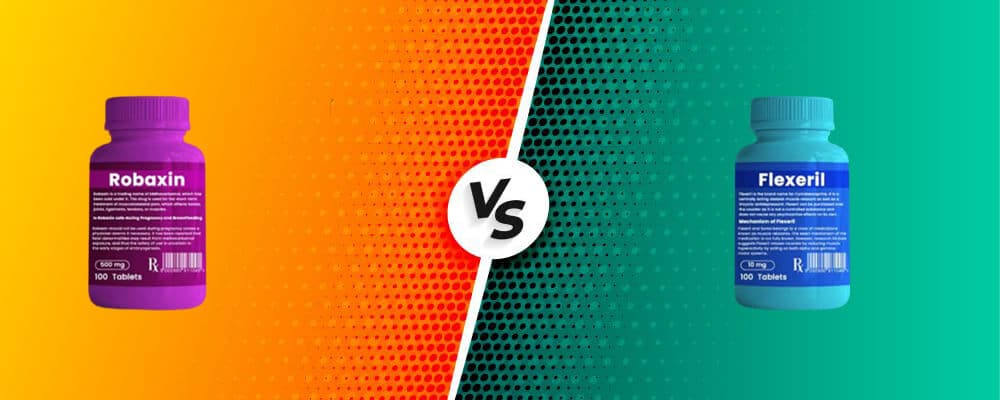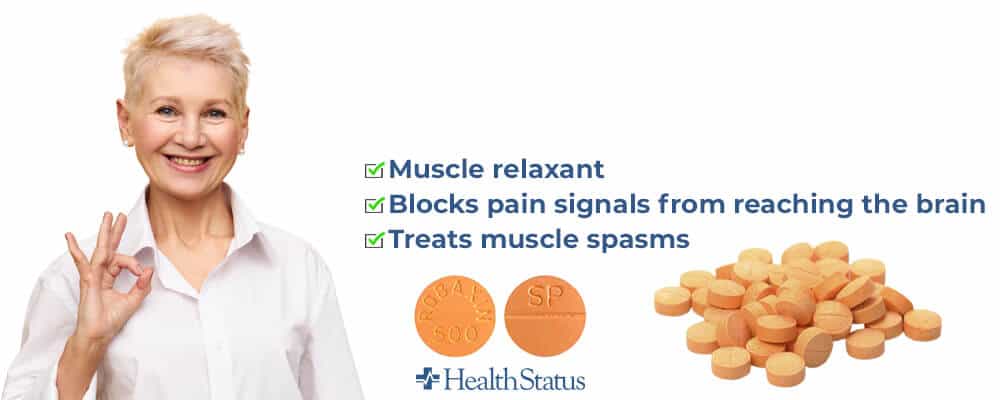
Robaxin offers excellent relief from muscle pain and it is useful in treating skeletal muscle spasm. All of us would have experienced muscle spasms or muscle cramps. Muscle spasms can happen anytime and they are totally unpredictable. The muscle spams can happen in the abdomen area, arms, hands, thighs, calves and feet. A muscle spasm can be painful and it can prevent us from handling our daily tasks even though they are a simple muscle condition. There are many muscle relaxation medications and treatments and we shall focus here on Robaxin.
Before you use Robaxin muscle relaxer, you need to check the latest Robaxin reviews. It is always helpful to have a complete understanding of Robaxin uses and Robaxin side effects. So that you could make a well-informed decision about this medicine. Before you buy Robaxin, you must also learn about the various Robaxin dosage options. So that you would know whether you need to order Robaxin 750 mg or Robaxin 500 mg. Doing adequate homework about Robaxin dosage, Robaxin uses and Robaxin side effects before ordering would never be out of place.
To make things easy for you, we have presented here one of the most detailed Robaxin reviews so that you can save a lot of time and get the required relief from muscle spasm by ordering Robaxin muscle relaxer.
What is Robaxin?
Robaxin is one of the best muscle relaxation pills that is used to treat muscle pain and muscle spasms. Robaxin is the brand name drug for Methocarbamol. Robaxin and Robaxin generic pills methocarbamol (Robaxin) are used to relieve muscle strains and muscle sprains. Robaxin is often used along with the other physical therapy and rest to achieve faster recovery from muscle spasms. Robaxin generic and brand name drug Robaxin are available in the form of injection is administered to treat lockjaw or tetanus.
Product name Robaxin Effects ✅ Muscle relaxant Side Effects Nausea, drowsiness, and headache. Package Bottles Dosage Eight pills per day Supply for Depends on the package chosen Price Robaxin 500 mg pills: 30 pills - $35.99 Shipping Free Reviews Refund Policy Only on non-delivery of the orders
✅ Blocks pain signals from reaching the brain
✅ Treats muscle spasms
60 pills - $60.99
80 pills - $80.99
120 pills - $100.99
180 pills - $143.99
270 pills - $202.99
360 pills - $262.99
What are Robaxin Ingredients?
Robaxin is a CNS – Central Nervous System depressant. It has sedative and musculoskeletal relaxant qualities. Robaxin or Robaxin generic drug methocarbamol (Robaxin) contains a chemical 3-(2-methoxyphenoxy)-1, 2 propanediol 1-carbamate. Robaxin muscle relaxer pills also contain other inactive ingredients such as Magnesium stearate, propylene glycol, corn starch, sodium lauryl sulfate, hydroxypropyl cellulose, stearic acid, polysorbate 20, povidone, FD&C Yellow 6, saccharin sodium, sodium starch glycolate, titanium dioxide and Hypromellose.
How does Robaxin work? How good is the effect of Robaxin for muscle relaxation?
As noted above, Robaxin or Robaxin generic is a CNS or Central Nervous System Depressant. Robaxin blocks the nerve impulses relating to pain that are sent to the brain and thereby prevents you from feeling the pain. As a muscle relaxant, Robaxin users are to be seen in its ability to relax the tightened muscles in a muscle spasm or muscle cramp. Robaxin is used along with physical therapy and rest to produce the best results. You will find Robaxin in various dosage strengths, including Robaxin 750 mg and Robaxin 500 mg. Selecting the right dosage is important for Robaxin or Robaxin generic to work for you.

How to use Robaxin for the best results?
Robaxin muscle relaxer is available in the form of pills. You can take Robaxin with or without food. To get the best results, use Robaxin with physical therapy. Ensure that you take adequate rest. The affected area should not be strained further. When taken with adequate rest and the right physical therapy, Robaxin is found to produce exceptional results. To get the best results, it is also important to order Robaxin from the right sources. Order from our partner vendor so that you have access to the authentic quality Robaxin pills.
Robaxin Dosage – How many Robaxin pills should you take?
Robaxin 500 mg and Robaxin 750 mg are the most commonly available dosage strengths. Take two pills four times a day. It has, however, been noted that taking just one tablet of the right strength thrice a day gives the expected relief. You should not exceed the recommended dosage, as it can produce undesirable side effects. In extreme cases Robaxin overdose could prove to be lethal. You should therefore adhere to the right Robaxin dosage guidelines. The maximum dosage per each serving shall not exceed 1500 mg. So if you order 750 mg, you need to take a maximum of 2 tablets per serving, 4 times a day. If you order 500 mg, you must take 3 tablets per serving 4 times a day.
How long does it take for Robaxin to work?
Robaxin muscle relaxer reviews indicate that Robaxin pills work in just 30 minutes and within 2 hours, it would produce the fullest results. However, you need to take the Robaxin pills as Robaxin results are short lived. Follow Robaxin dosage recommendations to enjoy continued pain relief.

Robaxin vs Flexeril
Robaxin reviews and Flexeril reviews indicate that both medicines are used to treat the same conditions as they both are muscle relaxants. Robaxin uses and Flexeril uses are therefore similar. They both give relief to pain, muscle spasms and muscle strains. So often users are confused when they compare Robaxin vs Flexeril. Even the Robaxin side effects and Flexeril side effects are similar. Users at times experience dizziness or drowsiness when taking the Robaxin as well as Flexeril.
However, in the Robaxin vs Flexeril debate, there are also a few important differences to be noted. Robaxin is the brand name drug for Methocarbamol and Flexeril is the brand name drug for Cyclobenzaprine. Robaxin is believed to relieve users from pain through its sedative properties. Robaxin does not directly impact the muscles. Flexeril, on the other hand, targets the brain stem and spinal cord. Flexeril is discontinued.
In the Robaxin vs Flexeril debate, you should note that methocarbamol (Robaxin) is used for both short term treatment and long term treatment. We limit Flexeril on the other hand to a maximum of two to three weeks use. If you are still running the debate on Robaxin vs Flexeril in your head, then we recommend Robaxin. You can order from our partner vendor and get immediate relief from your muscle pain and muscle spasm issues.

Robaxin vs Baclofen
Another contender that triggers a debate similar to Robaxin vs Flexeril is Baclofen. The Robaxin vs Baclofen debate too can be equally confusing. In the Robaxin vs Baclofen debate, you will notice that both Robaxin and Baclofen are muscle relaxants. Besides treating conditions such as muscle spasms and muscle rigidity, Baclofen is also used to treat other serious conditions, such as spinal cord injuries and spinal cord ailments. Lioresal and Gablofen are the brand name drugs for Baclofen. Robaxin side effects are similar to Baclofen side effects to a certain extent. However, there are certain side effects of Baclofen that are different from Robaxin side effects, which include urinary retention, urinary frequency increase, fatigue, respiratory issues and seizures. As Robaxin side effects are milder, we recommend methocarbamol (Robaxin) over Baclofen.

Robaxin 2024 clinical trial assessment and results: Is Robaxin safe to use?
Methocarbamol (Robaxin) is safe for use. You need to however follow the dosage guidelines. Increasing the dosage can lead to undesirable side effects and, at times, it could even prove to be lethal. Do not explore any off-label usage of Robaxin because such uses also may not be safe. As long as you are using Robaxin to treat muscle spasms and as long as you are using it to relieve muscle pain by taking the recommended dosage, it is totally safe.

Robaxin Side Effects
Robaxin reviews indicate that there are certain side effects on this drug. However, Robaxin side effects should not deter you from benefiting from Robaxin. Some of the Robaxin side effects include conditions such as drowsiness, nausea, stomach upset and blurry vision. In case you should experience any discomforts when taking Robaxin, you must make sure to get immediate medical attention.
Robaxin results before and after: does Robaxin really work or is it a scam?
Robaxin is an effective supplement, and it is not a scam. It gives relief from pain, discomfort caused by muscle spasms or muscle sprains.
- Robaxin results after two weeks: Robaxin is not a supplement that has a cumulative effect when taken on a long term basis. It starts working immediately, in as short as 30 minutes. You will be able to experience the fullest benefits in just 2 hours. If you continue experiencing muscle pain or discomfort due to muscle spasm, continue the daily dosage until you experience relief.
- Robaxin results after one month: If you take Robaxin for one month, you will get total relief from pain and muscle sprain related discomforts. It will block the nerve impulses and thereby block the pain. You will be able to continue with your daily routine despite muscle spasms or muscle sprains.

Our Robaxin reviews and rating: Robaxin pros and cons:
Robaxin customer reports indicate clearly that these pain relief pills are highly appreciated. They are very effective and they give relief from pain and discomfort in just two hours. We could see that Robaxin is well received and that it enjoys a good reputation.
Robaxin positive reviews
✅ Almost instant relief from pain: I had a terrible sprain in my calf, which was making it difficult for me to walk. Robaxin worked like magic and in just a couple of hours, I was relieved of my pain.
✅ The best pain relief treatment: Robaxin is the best pain relief treatment that I have come across so far. The results are very consistent and fast.
Robaxin negative reviews
❌ Adequate rest required for effectiveness: Only with adequate rest to the problem area, Robaxin is useful. On its own, without the required rest, Robaxin is not that effective for me.
Pros
- ✅ Fast acting formula
- ✅ Works for muscle spasms and muscle pain
- ✅ Safe for use
- ✅ Suitable for short term and long term use
Cons
- ❌ Overdosage can be fatal
- ❌ Additional physical therapy support is required

Robaxin reviews on the internet and forums like Reddit or Consumer Reports:
Robaxin has a very positive image, and this is mainly because Robaxin produces consistent results. The online discussions on Robaxin uses and Robaxin side effects indicate that Robaxin is one of the most sought after musculoskeletal pain relief treatments. You will also find reviews revolving around Robaxin vs Flexeril and Robaxin vs Baclofen. In these Robaxin alternative discussions, Robaxin is highly preferred by most users.
Are Robaxin reputable or are there any warnings about Robaxin on the internet?
Robaxin is a reputable drug for treating muscle pains, muscle spasms, or muscle sprains. There are no warnings about the correct use of Robaxin. However, there are warnings about exceeding the Robaxin dosage. Always keep to the Robaxin dosage and it will help you get the best results.

What do I need to consider if I want to discontinue Robaxin?
You can discontinue Robaxin anytime you like. Once you recover from your muscle spasm or muscle sprain, you can stop taking the pills. There are no dependency issues or withdrawal symptoms, as Robaxin does not have any psychoactive properties. However, discontinuing Robaxin pills before you get the required relief will leave you with pain and you will experience discomfort until you recover from your muscle spasm.
Where can you buy a Robaxin? Robaxin price comparison & deals for sale:
Visit our partner vendor to source Robaxin online. You will be able to save a considerable amount of money when you order Robaxin 500 mg or Robaxin 750 mg from our partner vendor. Here are the price details for Robaxin 500 mg:
- 30 pills – $35.99
- 60 pills – $60.99
- 80 pills – $80.99
- 120 pills – $100.99
- 180 pills – $143.99
- 270 pills – $202.99
- 360 pills – $262.99
Can you buy a Robaxin in a pharmacy?
When you order from our partner vendor, you will be able to save substantially. You will be able to get your Robaxin pills delivered to you directly by ordering it online.

Robaxin Review Conclusion - Our experience and recommendation:
Robaxin is a highly trusted muscle relaxant pill that is used to block the pain caused by muscle spasms or muscle sprains. It helps people overcome their muscle pain in just a couple of hours. Further to that, it is safe for use and when the correct dosage is followed, there will be no negative side effects. There are a number of other similar pills and muscle relaxants that spur debates such as Robaxin vs Flexeril and Robaxin vs Baclofen. However, we recommend Robaxin over the other muscle relaxants available in the market as Robaxin is safer and even if there are side effects; they are very mild. Order Robaxin from our partner vendor now and save on each order.

Frequently asked questions about Robaxin:
We have answered all your questions on Robaxin. You do not have to visit multiple platforms or websites looking for answers for various aspects such as Robaxin uses and Robaxin side effects.
What is Robaxin?
How to use Robaxin?
What is Robaxin used for?
How long does it take for Robaxin to work?
How long does Robaxin stay in your system?
What does Robaxin do?
How often can you take Robaxin?
What are the side effects of Robaxin?
What does Robaxin look like?
Robaxin vs Flexeril, which is stronger?
Where to buy Robaxin for sale online?
Are there any Robaxin discount or coupon codes?
Is it possible to buy a Robaxin on eBay and Amazon?
Are there any criticisms of Robaxin or is it recommended to take Robaxin?
Is it safe to take Robaxin continuously?
Do I need a prescription to buy a Robaxin?
Resources
- https://pubmed.ncbi.nlm.nih.gov/32279727/, Accessed Date: 14 Apr 2022.
- https://www.bmj.com/content/374/bmj.n1446, Accessed Date: 14 Apr 2022.
- https://jamanetwork.com/journals/jamanetworkopen/fullarticle/2767591, Accessed Date: 14 Apr 2022.
- https://www.health.harvard.edu/back-pain/low-back-pain-attacks-one-pill-may-be-enough, Accessed Date: 14 Apr 2022.


